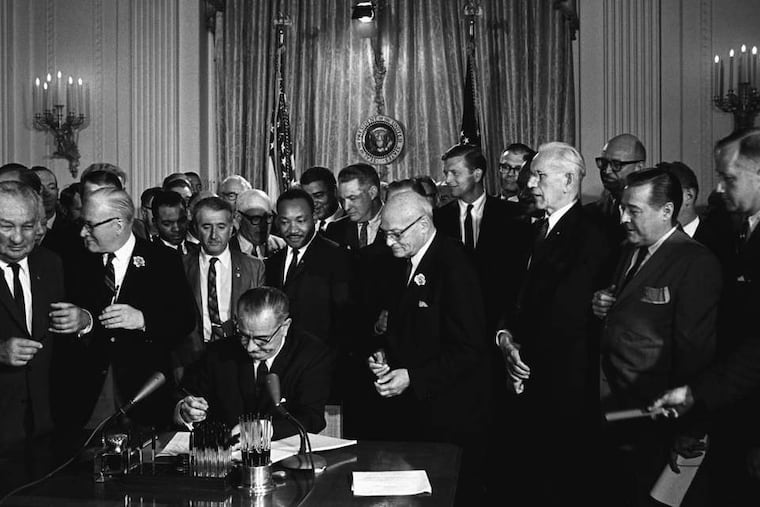Civil rights battle fought on two fronts
On April 7, 1964, a week after Southern Democrats began their marathon filibuster against the Civil Rights Act, a 27-year-old Presbyterian minister named Bruce Klunder joined a protest against a segregated school construction project in Cleveland. Klunder laid down behind a bulldozer while several other protesters rallied in front of it, hoping to stop the machine. Instead, the driver, not seeing Klunder, backed up, killing him.

On April 7, 1964, a week after Southern Democrats began their marathon filibuster against the Civil Rights Act, a 27-year-old Presbyterian minister named Bruce Klunder joined a protest against a segregated school construction project in Cleveland. Klunder laid down behind a bulldozer while several other protesters rallied in front of it, hoping to stop the machine. Instead, the driver, not seeing Klunder, backed up, killing him.
On June 21, more than two months after Klunder's death and less than two weeks after the Senate defeated the Southern filibuster, three civil-rights workers in Mississippi - James Chaney, Andrew Goodman and Michael Schwerner - were arrested, kidnapped, and executed by members of the Ku Klux Klan.
When we think about the Civil Rights Act, our minds are drawn to scenes of obstructionist Southern politicians and presidential arm-twisting. But we often forget the broader context of activism and protest in which the bill's long journey across Capitol Hill took place.
These two stories - the political theater inside the Capitol, and the violent tumult of civil-rights protests outside it - did not happen independently. Each drove the other. Few pieces of legislation in American history have been as intimately connected to its social context as the Civil Rights Act.
This relationship went back to the very birth of the bill. One of the goals of the Rev. Dr. Martin Luther King Jr., with his protest campaign in Birmingham, Ala., in the spring of 1963, was to spur federal action to take on the Jim Crow South.
As King said in a sermon on May 7, "The hour has come for the federal government to take a forthright stand on segregation in the United States . . . I am not criticizing the president, but we are going to have to help him."
Over the next few weeks, President John F. Kennedy, having finally awoken to the moral urgency of protecting civil rights, had Justice Department lawyers working overtime on a comprehensive civil rights bill, which he announced on June 11 - hours after Alabama Gov. George Wallace tried to prevent the integration of the University of Alabama, and just hours before the murder of NAACP leader Medgar Evers in Jackson, Miss.
King and other civil-rights leaders gave the bill another boost in August with the March on Washington, which brought 250,000 people to the capital. Though it had little immediate impact on congressional vote counts, the march, which was televised into millions of homes, rammed home for ordinary white Americans the peaceful, righteous nature of the movement's demands - creating a wave of public support for the bill as it trundled through the House and Senate over the next 10 months.
Almost three weeks later, tragedy struck, when four young girls were killed by a bomb planted inside Birmingham's 16th Street Baptist Church. As awful as it was, their murder, and the national indignation it unleashed, opened the door for the bill's supporters to strengthen it significantly, adding what became a landmark ban on employment discrimination.
Throughout the fall of 1963 and the following winter, the spear point for strengthening the bill was not liberal congressmen, but the lobbyists from the NAACP, United Auto Workers, and National Council of Churches, who brought thousands of civil-rights workers, preachers, rabbis, and union members to Washington.
These activists not only won a stronger bill, but also convinced conservative Republican House members to join their liberal colleagues in voting for the legislation. It passed the House by an overwhelming 290 to 130 votes on Feb. 10.
Much the same story played out once the bill crossed into the Senate, where it was met by an epic filibuster by Southern Democrats. In the past, the pro-segregation Southerners had managed to defeat or dilute civil rights legislation - but not this time.
The front line of support for the bill came from the pro-civil rights senators, Department of Justice officials, and, of course, President Lyndon B. Johnson. But working alongside them, and goading them forward, were thousands of lobbyists, ministers, and everyday Americans, who held rallies in their hometowns and took buses to Washington to meet with senators and pack the Senate viewing gallery.
At one point senators reported receiving a thousand letters a week each, almost all of it in support of the bill.
"Washington has not seen such a gigantic and well-organized lobby since the legislative days of the Volstead Act and the Prohibition amendment," said Richard Russell, the leader of the pro-segregation Southern Democrats, in a mix of frustration and awe.
Such activism, virtually unprecedented in American political history, did not guarantee the bill's success - it was, after all, a piece of legislation up against a filibuster, which meant that at least two-thirds of the Senate had to support it.
But this massive showing of support demonstrated a sharp sense of moral urgency on the part of the American public, particularly in places like Iowa or rural California, where blacks were few and race was a nonissue.
And it worked: Senators who might have otherwise ignored the bill or sought a compromise instead found themselves compelled by their constituents to back the bill, and make racial justice a reality for millions of their fellow citizens.